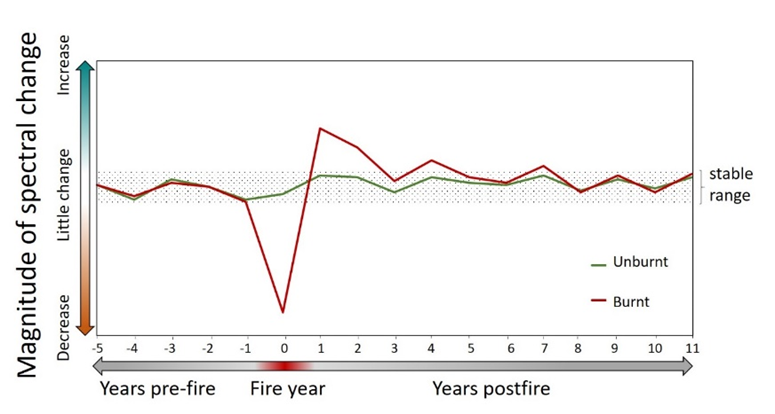6. Post-fire Recovery Monitoring
NSW Post-fire Biomass Recovery Monitoring for 3 years following 2019–20
Remote sensing scientists at NSW DCCEEW have developed a novel approach for broad-scale, early monitoring of post-fire biomass recovery. Observational monitoring of post-fire biomass recovery is important to help us understand drivers of recovery processes, identify vulnerable ecosystems and prioritise management to support ecological resilience.
Following the extreme bushfire season of 2019–20, there is concern regarding the pressure on ecological resilience particularly due to short inter-fire intervals. The report summarises the method and analysis of post-fire recovery trajectories across the 2019–20 fire ground. Overall, there has been a widespread and vigorous post-fire biomass response. This is typical in the resprouter dominated forests across much of New South Wales. However, the data also highlight areas of limited or delayed post-fire recovery.
The intended use of the data is for early monitoring of post-fire recovery of vegetation cover at the landscape scale to help identify potentially vulnerable ecosystems. The mapping must not be interpreted as a surrogate estimate for all levels of post-fire ecological recovery. There may be additional areas of concern not highlighted by this method.
Method Overview
The NSW post-fire biomass recovery monitoring system is based on the concept that a disturbed system state will be reflected by high rates of system change, while undisturbed or recovered system states are characterised by near-zero rates of change. This reflects the typical pattern of diminishing rates of spectral change in post-fire recovery trajectories, as the burnt area initially shows post-fire changes until it eventually returns to a stable state (Fig 1).
This method overcomes major limitation of other approaches that attempt to estimate post-fire recovery in comparison to a defined pre-fire state. These approaches are strongly influenced by the methods used to define the pre-fire state and are likely to be confounded by climatic fluctuations over various timeframes. Our novel approach tracks recovery dynamics over space and time in the post-fire environment, without reference to pre-fire conditions. By comparing standardised measures of the magnitude of change in vegetation cover and greenness within burnt and surrounding unburnt areas, patterns of recovery can be compared between fires across the landscape. Compilation of sequential annual maps over the longer term can indicate when the burnt area has reached a stable state. A stable state may be indicated when post-fire recovery values represent little to no change, and where all fire severity classes are synchronised with surrounding unburnt areas over multiple consecutive years. This may indicate either recovery to the pre-fire state, or an alternative stable state, but the distinction cannot be determined from this remote sensing method.

Figure 1. Conceptual diagram of typical patterns of spectral change in post-fire timeseries.
The published method paper contains more detailed information:
Delayed Recovery Index
One of the important applications of the NSW Post-fire Biomass Recovery Monitoring system is to identify areas of potential vulnerability through assessment of recovery dynamics at the broad statewide scale. Based on the field results of post-fire recovery at high severity, short fire interval sites, the following thresholds were used to delineate areas of limited or delayed post-fire recovery at the statewide scale:
• less than 12 (very large increase) in the year 1 post-fire recovery product
• less than 9 (small increase) in the year 2 post-fire recovery product
• burnt at high or extreme severity in the 2019–20 FESM product.
This broad-scale assessment is intended to highlight areas across New South Wales with limited or delayed post-fire recovery that may warrant closer investigation. These atypical recovery dynamics may indicate potential threats to ecosystem resilience. However, in some locations, these patterns may be related to the dominant post-fire response traits of the community or the natural productivity of the local environment. A comprehensive, scientifically robust analysis to quantify the drivers of post-fire recovery following the 2019–20 fires, and the influence of compounding stressors, is highly recommended.
Linked Datasets
-
Observational monitoring of post-fire biomass recovery at the landscape scale is important to help us understand drivers of recovery processes, identify vulnerable ecosystems and p ...
- URL
- ZIP